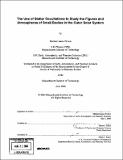The use of stellar occultations to study the figures and atmospheres of small bodies in the outer solar system
Author(s)
Person, Michael James
DownloadFull printable version (8.312Mb)
Other Contributors
Massachusetts Institute of Technology. Dept. of Earth, Atmospheric, and Planetary Sciences.
Advisor
James L. Elliot.
Terms of use
Metadata
Show full item recordAbstract
The methods of analyzing stellar occultations by small bodies in the outer solar system are discussed with examples from Triton, Pluto, and Charon. Simulations were performed characterizing the analysis of multi-chord occultations including: the effects of the direction of residual minimization in figure fits, the complications in measuring the reliability of fitted figure parameters when there are few degrees of freedom, and the proper treatment of grazing chords in model fitting. The 2005 July 11 C313.2 stellar occultation by Charon was analyzed. Occultation timings from the three published data sets were combined to accurately determine the mean radius of Charon: 606.0 ± 1.5 km. The analysis indicates that a slight oblateness in the body (0.006 ± 0.003) best matches the data, with a confidence level of 86%. Charon's mean radius corresponds to a bulk density of 1.63 0.07 g/cm3, which is significantly less than Pluto's (1.92 ± 0.12 g/cm3), consistent with an impact formation scenario in which at least one of the impactors was differentiated. The 2002 August 21 P131.1 and the 1988 June 9 P8 stellar occultations by Pluto were analyzed. (cont.) The ellipticity of Pluto's atmosphere as measured by the P131.1 event is 0.066 ± 0.040, with a Gaussian confidence level of 63%, and the ellipticity as measured by the P8 occultations is 0.091 ± 0.041, with a Gaussian confidence level of 70%. If this non-sphericity is confirmed, its size and variation could possibly be attributed to super-rotating winds driven by sources such as surface frost migration due to changing insolation patterns or albedo properties, gravity waves, and an asymmetric mass distribution in Pluto itself. The 2001 August 23 Tr231 stellar occultation by Triton was analyzed. The half-light radius of Triton's atmosphere was calculated from astrometrically calibrated model fits to the occultation light curve. The resulting half-light radius of 1479.01 km is larger than the value of 1456.3 km derived from the 1997 Trl80 occultation, with a confidence of 77% derived from the uncertainty in the astrometric calibration. If this increase were confirmed, it would indicate that the expansion of Triton's atmosphere detected between the 1989 Voyager 2 observations the 1995 and 1997 stellar occultations by Triton has continued through 2001.
Description
Thesis (Ph. D.)--Massachusetts Institute of Technology, Dept. of Earth, Atmospheric, and Planetary Sciences, 2006. Includes bibliographical references (p. 111-117).
Date issued
2006Department
Massachusetts Institute of Technology. Department of Earth, Atmospheric, and Planetary SciencesPublisher
Massachusetts Institute of Technology
Keywords
Earth, Atmospheric, and Planetary Sciences.